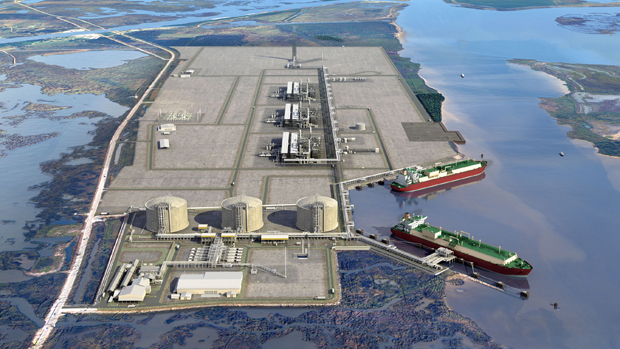 Thailand’s Map Ta Phut LNG terminal will run at full capacity in 2016 to offset the planned production cut. (Qatargas)
Thailand’s Map Ta Phut LNG terminal will run at full capacity in 2016 to offset the planned production cut. (Qatargas)
Thailand has announced plans to cut domestic gas production and import more low-cost spot LNG in an effort to conserve its waning reserves.
The government aims to reduce output from the Gulf of Thailand by 10%, from around 79 million cubic metres per day (MMcm/d) at present to 71 MMcm/d by next year, Director General of the Mineral Fuels Department Veerasak Pungrassamee said in a note earlier this month.
This will help extend flows from fields in the gulf until 2025. These fields operate at an average cost of $30-40 per barrel of oil and are fast depleting.
At $4-5/MMBtu spot LNG can be imported for less than the cost of gas production in the Gulf of Thailand, so state-backed energy company PTT could look to optimise costs by nominating less piped gas at home, Zhi Xin Chong, an LNG expert at energy research company Wood Mackenzie, told Natural Gas Daily.
Veerasak said the 5 mtpa Map Ta Phut LNG terminal will run at capacity in 2016 to help offset the planned production cut. The regasification facility, which will be expanded to handle 10 mtpa by 2017, is located in the eastern province of Rayong.
However, PTT recently announced it would delay its long-term LNG buying plans, opting to buy cargoes from the spot market instead. PTT can secure prices of $6-7/MMBtu, significantly cheaper than long-term deals, Noppadol Pinsupa, vice president of PTT gas business, told local media.
Last August Thailand agreed long-term contracts with BP and Shell for 1 mtpa of LNG from each company. Thailand already has a 2 mtpa supply deal in place with Qatargas, which began in 2014 and runs for 20 years.
But PTT is in talks with BP and Shell to delay the import deals, which are being reviewed by the Thai authorities, according to Noppadol. The contracts, if finalised, would have come into effect from April 2016, with initial imports of 500,000 tons of LNG from Shell and 317,000 tons from BP.
Chong expects Thailand’s annual LNG demand to hit 7 mt by 2020, which means the country will import about 3 mtpa of spot LNG if the deals with BP and Shell go through.
Noppadol said lower-than-expected domestic demand means Thailand will need only 2.7 mt of LNG this year, slightly up from 2.6 mt in 2015 but markedly lower than an earlier estimate of 5 mt.
Domestic gas demand is forecast to dip from 136 MMcm/d in 2015 to 133 MMcm/d this year. However, demand growth is expected to average 2% per year over the next five years.
Aside from expanding its existing LNG terminal, PTT has also mooted plans to build a second import facility with a capacity of 7.5 mtpa.
Thailand is heavily reliant on gas for power – the fuel accounts for 70% of electricity generation. But total proven gas reserves – 200 bcm at the end of 2014 – will only last 6-7 years at current consumption rates, threatening the country’s energy security.
Exploration
Meanwhile, the 21st upstream licensing round has been on hold since 2007, stalling exploration as energy demand continues to climb.
Uncertainty surrounding the extension of legacy production contracts operated by Chevron and the newly merged BG-Shell group, set to expire by the early 2020s, has also stymied investment. Thailand’s fiscal regime, widely applauded by investors, has come under attack from powerful NGOs that claim it is too generous. As a result, the country’s Petroleum Act is being reviewed and its upstream sector is at risk.
Still, there is room for optimism. General Anantaporn Kanjanarat, who replaced Narongchai Akrasanee as energy minister in a surprise move last August, is widely expected to push forward the long-delayed upstream bidding round and resolve the question of expiring licences. Veerasak said his department would announce the latest upstream licensing round in May this year.
But Adrian Pooh, an upstream specialist at Wood Mackenzie, does not expect the round to be launched until late 2016 at the earliest. "There has been some back and forth with the opposition and NGOs, who want to include a [production-sharing contract] option and potentially a risk service contract," he told NGD.
Licensing round decisions could even be delayed until after the general elections planned for late 2016 or early 2017, he said. Although the new regime has not been officially announced, overall it is unlikely to be much less attractive to investors, Pooh added.
Anantaporn has said his priorities are improving Thailand’s energy security and resolving the Overlapping Claims Area (OCA) dispute with neighboring Cambodia, which could boost Thailand’s gas reserves by as much as 65%, as well as encouraging billions of dollars of spending and replacing the need for rising energy imports.
Cambodia and Thailand have both awarded blocks in the OCA, which aside from addressing revenue sharing and fiscal regimes, means the issue of dual licensing needs to be overcome. Cambodia split the OCA into four areas, while Thailand awarded 11 blocks. The prospective waters are thought to hold 227-425 bcm of gas, according to estimates from the South East Asian Petroleum Exploration Society.






